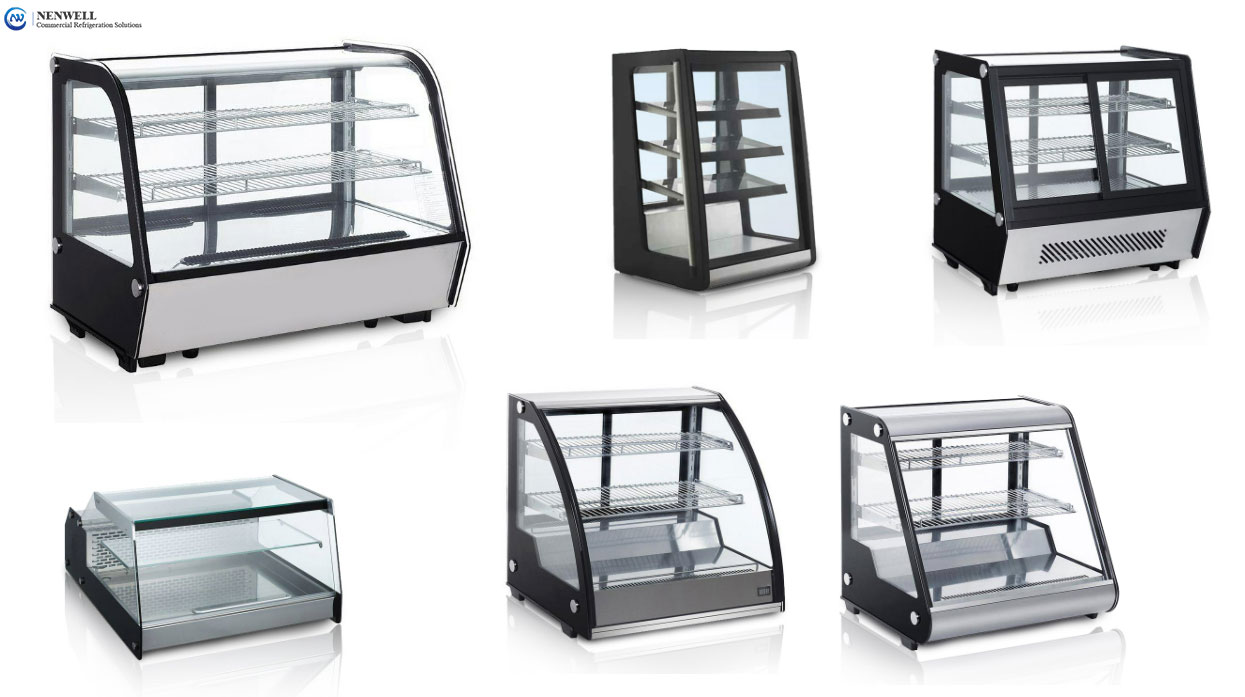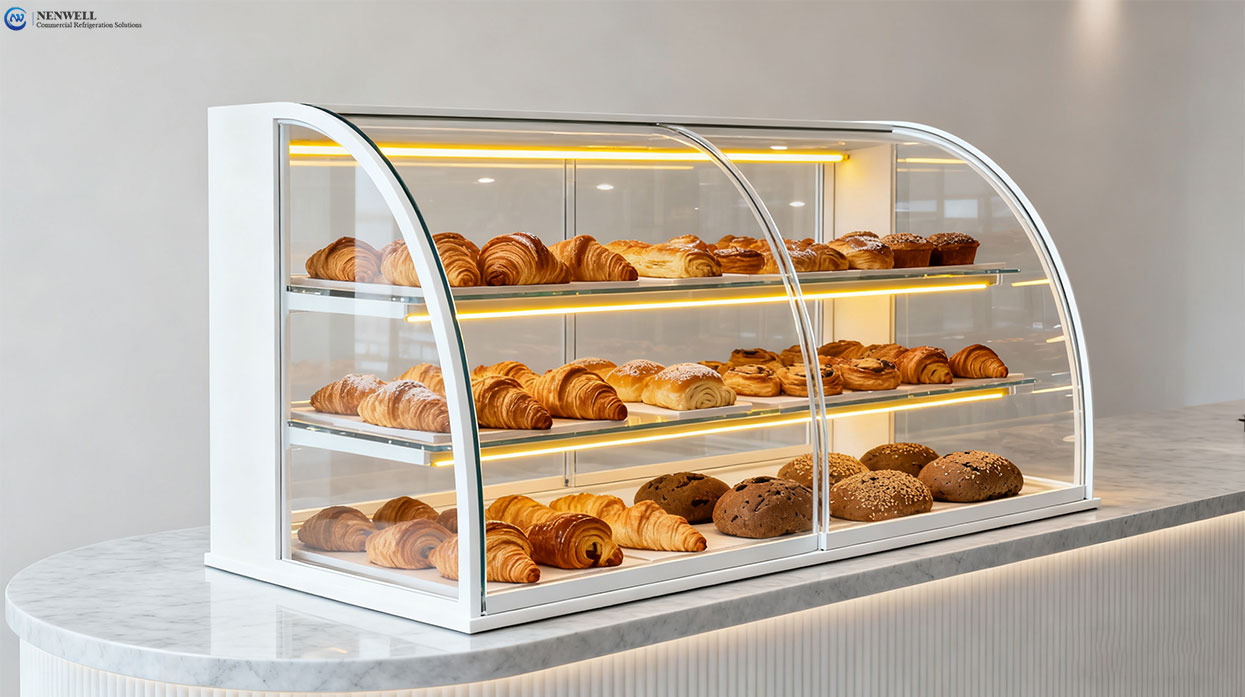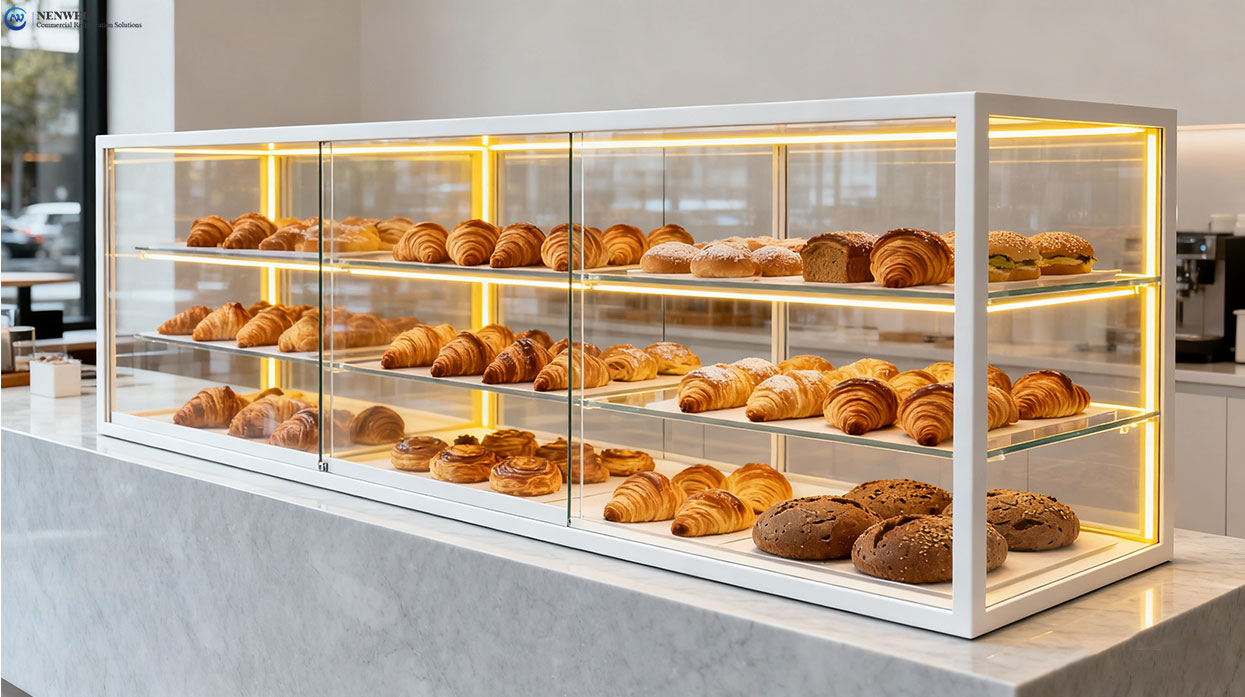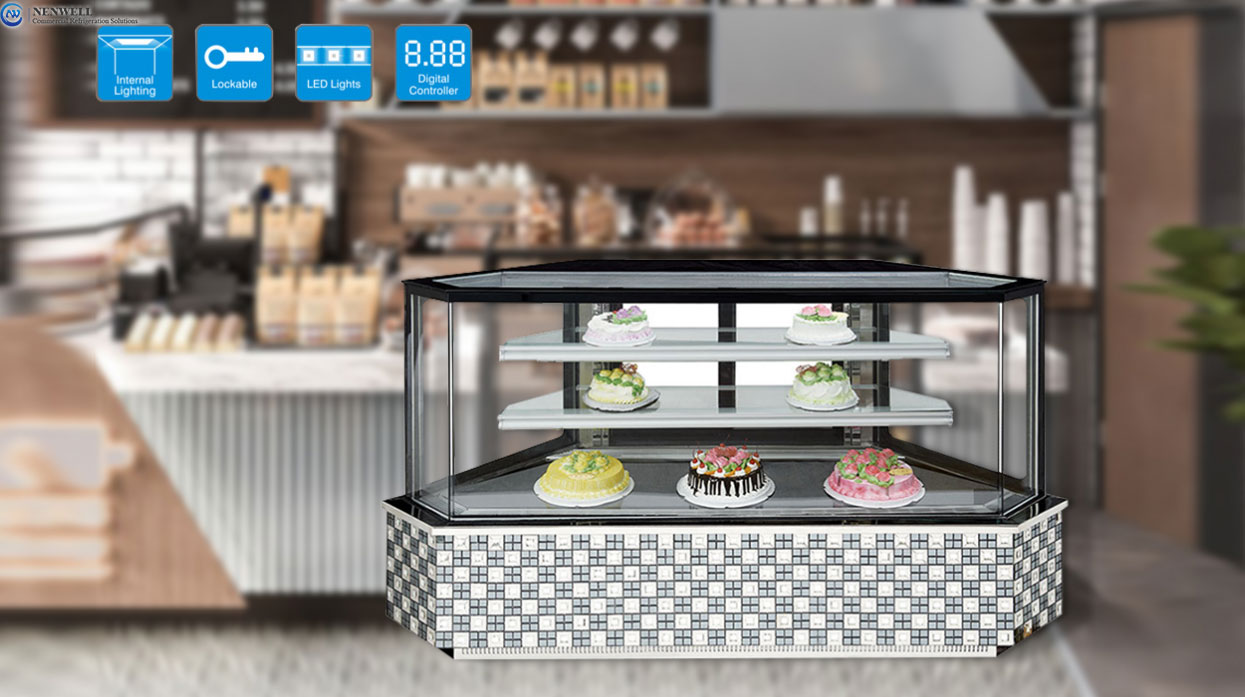“With so many types of bakery display cases, such as curved cabinets, island cabinets, and sandwich cabinets, which one is the right choice?” It’s not just beginners; many seasoned bakery owners can also get confused when it comes to the different types of refrigerated display cases.
I. Classification by “Appearance & Structure”: Different Shapes for Different Store Scenarios
The decoration style and size of the bakery directly determine the choice of display case appearance. The common types are as follows:
1. Curved Refrigerated Display Cases: The “Beauty Icon” for Highlighting Single Items
The glass doors of curved cabinets feature an arc design, providing a near-unobstructed view. They are especially effective in showcasing the delicacy of “aesthetically pleasing” products like cakes and artisanal bread. For instance, when displaying birthday cakes or intricately designed mousses, the lighting in a curved cabinet allows customers to clearly see every detail from all angles.
Suitable Scenarios: High-end bakeries, dessert shops, or areas at the store entrance where best-selling items need to be prominently displayed. Minor Drawback: Due to its unique shape, it occupies slightly more horizontal space compared to right-angled cabinets, so small stores should measure carefully before choosing.
2. Right-Angled Refrigerated Display Cases: “Space Savers” Friendly to Small Stores
Right-angled cabinets have a square and upright design, and their biggest advantage is space efficiency. Whether used as side cabinets against the wall or small display cases within the counter, the right-angled design fits snugly into the space without wasting any extra area.
Suitable Scenarios: Community bakeries or those with limited counter space, ideal for displaying ambient-temperature bread and small portions of desserts. Note: When selecting, check if the internal shelves can be adjusted, as bread comes in various sizes, and adjustable shelves allow for more flexible storage of different products.
3. Island Bakery Cabinets: The “Interactive Centerpiece” for Creating a Shopping Atmosphere
Island cabinets are open (or semi-open) display cases placed in the middle of the store, allowing customers to access products from multiple sides. They not only display bread but also serve as the core of the shopping flow, naturally guiding customers to browse around the cabinet and increasing their dwell time.
Suitable Scenarios: Larger comprehensive bakeries, especially those aiming to create a “self-service supermarket feel”. Plus Point: High-quality island cabinets come with a temperature control system. Even if they are open, internal cold air circulation can maintain the freshness of bread (or refrigerated products).
4. Drawer-Type/Push-Pull Door Refrigerated Cabinets: The Dual “High-End + Practicality” Features
Drawer-type display cases store products in drawers, giving customers a sense of ceremony when they open the drawers to pick up items. Single-layer push-pull door cabinets have a sleek and sophisticated appearance. Both types are niche yet enhance the overall quality.
Suitable Scenarios: High-end bakeries and specialty coffee shops, suitable for displaying premium cakes and limited-edition desserts to highlight the “scarcity” of the products. Reminder: These cabinets usually have limited capacity, making them suitable for a “less but better” product layout.
5. Corner/Embedded Refrigerated Cabinets: The “Savior for Space Corners”
Corner cabinets are specifically designed for store corners, making use of 90-degree corner spaces. Embedded cabinets can be directly integrated into the counter or wall, resulting in a neater overall decoration.
Suitable Scenarios: Stores with awkward spaces or those looking to create an “integrated counter”, such as bakeries and coffee shops. Key Point: Before customization, confirm the dimensions with the renovation team to avoid issues like improper fitting or large gaps.
II. Classification by “Function & Scenario”: Different Products Require Different Refrigeration Needs
Bakeries offer a wide variety of products, some requiring ambient temperature storage, some refrigeration, and others needing to be displayed in combination with ambient-temperature items. Therefore, the functions of display cases should be tailored accordingly.
1. Cake Refrigerated Display Cases: The “Moisture-Retaining + Temperature-Controlling” Exclusive Guardian for Cream Cakes
Cakes, especially mousses and cream cakes, are highly sensitive to dryness and temperature fluctuations. These display cases focus on “precise temperature control (usually 1℃ – 10℃) + moisture retention”. The cabinet doors are typically made of double-layer anti-fog glass, which not only allows customers to have a clear view but also prevents internal water vapor from condensing into fog and blocks external moisture, avoiding frosting or softening of the cake surface.
Suitable Scenarios: Stores mainly selling cakes, such as home bakeries transitioning to physical stores. Additional Advantage: High-quality cake cabinets offer options between “forced-air cooling” and “direct cooling” (more on cooling methods later) and come with LED lighting to make the cakes look even more appealing.
2. Sandwich/Light Meal Refrigerated Cabinets: The “Guardians of Ready-to-Eat Foods” Focused on Cold Food Preservation
These cabinets emphasize “insulation (or refrigeration) duration” because ready-to-eat products like sandwiches and salads need to maintain their taste at specific temperatures, neither freezing hard nor spoiling. Some also have a layered design for convenient categorization of sandwiches with different flavors.
Suitable Scenarios: Bakeries specializing in light meals and simple cuisine, or community stores selling sandwiches during breakfast. Caution: If bread is the main product in the store, the use of these cabinets may be limited, so don’t choose them blindly just to “diversify the product range”.
3. Combination Display Cases: “One Cabinet, Multiple Uses” Ideal for Stores with Diverse Products
Combination cabinets usually have dual-temperature zones, a refrigerated area for cakes and yogurt, and an ambient-temperature area for bread and pastries. For stores with a wide product range, instead of buying two separate cabinets, a combination cabinet can solve the problem and also save on electricity bills (since only one compressor needs to run).
Suitable Scenarios: Comprehensive bakeries with a rich product line, especially those selling bread, cakes, and yogurt simultaneously. Tip: When choosing a combination cabinet, check if the partitions between the two temperature zones can be adjusted, enabling you to change the proportion of refrigerated/ambient-temperature products according to the season.
4. Open Dessert and Yogurt Cabinets: Maximizing Interaction, Focusing on Self-Service Experience
These cabinets do not have fully enclosed doors, allowing customers to directly see (and even reach for) the desserts and yogurt inside, providing a highly interactive experience. However, due to their open design, higher requirements are placed on in-store hygiene and temperature control—the store needs to be kept cool to prevent the open cold cabinet from losing its cool temperature.
Suitable Scenarios: Internet-famous bakeries popular among young customers or the “self-service area” of community stores. Essential Detail: The interior should have a circulating cold air design to ensure that even when open, the cold air evenly surrounds the products; otherwise, the yogurt may warm up and affect its taste.
III. Finally, Consider the “Cooling Method”: Forced-Air Cooling VS Direct Cooling, Each with Its Advantages and Disadvantages
Besides appearance and function, the cooling method also affects the user experience of the display case. The common types are “forced-air cooling” and “direct cooling”:
1. Forced-Air Cooling Display Cases: “Even Temperature, but Slightly Drying”
These cases circulate cold air with built-in fans. The advantage is that the temperature inside the cabinet is extremely uniform, with minimal temperature differences between the corners and the center, and they do not frost, eliminating the need for frequent defrosting. However, the drawback is that the circulating cold air can draw out moisture, causing the surface of exposed bread (especially soft artisanal bread) to dry out over time.
Suitable For: Cakes, yogurt, and packaged bread (the packaging helps retain moisture).
2. Direct Cooling Display Cases: “Good Moisture Retention, but Requires Defrosting”
These cases cool by natural heat dissipation from the tubes. The advantage is that water vapor is less likely to escape, allowing exposed bread and pastries to maintain a soft texture. The disadvantage is that they are prone to frosting, requiring manual defrosting at regular intervals, and the temperature inside the cabinet may be slightly uneven (areas closer to the tubes are colder).
Suitable For: Unpackaged freshly baked bread and pastries that require moisture retention.
IV. Three “Practical” Tips for Choosing a Refrigerated Display Case
After learning about so many types, you might ask, “How do I choose?” Here are some practical suggestions:
- First, List Your Products: Make a list of the products that will be placed in the display case (e.g., “60% bread, 30% cakes, 10% yogurt”) and then select a cabinet that matches the functions. Don’t be swayed by the “good looks” of a cabinet; prioritize practicality.
- Measure Your Store Space: Especially for small stores, don’t just choose a cabinet based on pictures. Buying a cabinet that blocks the aisles or doesn’t fit the reserved space is a waste. It’s best to measure the length, width, and height carefully with a tape measure and confirm the dimensions with the manufacturer.
- Inquire About After-Sales Service: Display cases are long-term equipment, and issues with the compressor or refrigeration system can be troublesome. Before choosing, ask the manufacturer about “the warranty period” and “the availability of local repair points”. Don’t opt for small brands without after-sales service just to save money.
There Is No “Best Display Case”, Only the “Most Suitable” One
Curved cabinets are aesthetically pleasing, while right-angled cabinets save space; cake cabinets specialize in preserving cream, and combination cabinets serve multiple purposes… The key to choosing a refrigerated display case for a bakery is to “match your products and store”. As long as you remember to “first consider the products, then the space, and finally the cooling method”, you can select the most suitable one even when faced with dozens of types.
Post time: Oct-15-2025 Views:




